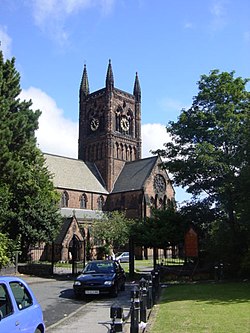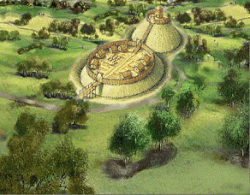West Derby: Difference between revisions
Created page with "{{infobox town |county=Lancaster |picture=St Mary's Church, West Derby - geograph.org.uk - 37445.jpg |picture caption=St Mary's Church |latitude=53.4338 |longitude=-2.9070 |po..." |
m →History: clean up, replaced: medieval → mediæval |
||
| Line 23: | Line 23: | ||
[[File:Westderbycastle.gif|thumb|250px|West Derby Castle]] | [[File:Westderbycastle.gif|thumb|250px|West Derby Castle]] | ||
There still remains a courthouse built in the reign of Queen Elizabeth I: the first (Wapentake) court in West Derby was established around 1,000 years ago.<ref>{{citation|url=http://www.bbc.co.uk/liverpool/localhistory/mersey_times/issue_05/west_derby_village/court_house.shtml|title=Mersey Times: Court House|publisher=BBC Liverpool|accessdate=27 June 2008}}</ref> The West Derby Courthouse, built in 1586, was restored and conserved in 2005 and is the only freestanding post- | There still remains a courthouse built in the reign of Queen Elizabeth I: the first (Wapentake) court in West Derby was established around 1,000 years ago.<ref>{{citation|url=http://www.bbc.co.uk/liverpool/localhistory/mersey_times/issue_05/west_derby_village/court_house.shtml|title=Mersey Times: Court House|publisher=BBC Liverpool|accessdate=27 June 2008}}</ref> The West Derby Courthouse, built in 1586, was restored and conserved in 2005 and is the only freestanding post-mediæval courthouse in Britain.<ref>{{citation|url=http://www.croxteth.co.uk/news/2007/Court.asp|title=West Derby Courthouse (News 2007)|publisher=croxteth.co.uk|accessdate=27 June 2008}}</ref> The tiny Grade-II* listed building is open to the public between 2 pm and 4 pm every Sunday except Easter from April to October inclusive, admission free. | ||
Opposite the courthouse is a set of Victorian cast-iron stocks once used as a public restraint for offenders. Villagers used fruit and rotten vegetables to throw at the offenders. The stocks were placed in their current position to commemorate the coronation of Edward VII in 1902. Temporarily removed in 2008 whilst the site was renovated, the stocks have since been put back in place. | Opposite the courthouse is a set of Victorian cast-iron stocks once used as a public restraint for offenders. Villagers used fruit and rotten vegetables to throw at the offenders. The stocks were placed in their current position to commemorate the coronation of Edward VII in 1902. Temporarily removed in 2008 whilst the site was renovated, the stocks have since been put back in place. | ||
Revision as of 11:57, 30 January 2021
| West Derby | |
| Lancashire | |
|---|---|
 St Mary's Church | |
| Location | |
| Grid reference: | SJ396932 |
| Location: | 53°26’2"N, 2°54’25"W |
| Data | |
| Population: | 14,382 (2011) |
| Postcode: | L12 |
| Dialling code: | 0151 |
| Local Government | |
| Council: | Liverpool |
| Parliamentary constituency: |
Liverpool West Derby |
West Derby is a village in Lancashire which has become a suburb in the north of Liverpool. At the 2011 Census, the population was of the West Derby ward was 14,382.[1] The village gives its name to the West Derby Hundred of Lancashire.
History
Mentioned in the Domesday Book, West Derby achieved significance far earlier than Liverpool itself.[2] The name West Derby comes from an Old Norse word meaning "place of the wild beasts" or "wild deer park" and refers to the deer park (now Croxteth Park) established there by King Edward the Confessor. West Derby became the main administrative area in today's Liverpool for the Norman Conquests and was the largest area within the West Derby Hundred.[3]
West Derby once had a Motte-and-Bailey castle, now completely disappeared. There is also some suggestion of a Roman site on a street called Castlesite (nicknamed "The Rosies" by some locals). The site is now a small public park, the shape and dimensions of which are similar to that of a Roman barracks or castra. The remnants of a wooden castle were unearthed on this plot during excavations in the mid 1930s. The Earls of Derby were conferred their title from West Derbyshire, and not as commonly thought Derbyshire and ultimately from where the word Derby for horse races is derived.

There still remains a courthouse built in the reign of Queen Elizabeth I: the first (Wapentake) court in West Derby was established around 1,000 years ago.[4] The West Derby Courthouse, built in 1586, was restored and conserved in 2005 and is the only freestanding post-mediæval courthouse in Britain.[5] The tiny Grade-II* listed building is open to the public between 2 pm and 4 pm every Sunday except Easter from April to October inclusive, admission free.
Opposite the courthouse is a set of Victorian cast-iron stocks once used as a public restraint for offenders. Villagers used fruit and rotten vegetables to throw at the offenders. The stocks were placed in their current position to commemorate the coronation of Edward VII in 1902. Temporarily removed in 2008 whilst the site was renovated, the stocks have since been put back in place.
The area was home to the Earls of Sefton (family name Molyneux), whose house, Croxteth Hall, and the surrounding countryside estate now forms Croxteth Park, an attractive public space.
Organisations
Alder Hey Children's Hospital is located on the south side of West Derby, at Eaton Road.
Both Everton, and Liverpool football clubs located their training grounds in West Derby, Everton at Bellefield and Liverpool at Melwood. However, in 2007 Everton moved to their new complex in south Liverpool called Finch Farm.
The West Derby Society was founded in 1977 and holds regular monthly meetings and outings. It also lobbies on planning and environmental issues. The West Derby Community Association, a registered charity, owns Grade II-listed 'Lowlands' in West Derby. This 1846 mansion underwent restoration and renovation with the help of a £1 million Heritage Lottery Fund grant.[6]
Education
West Derby is home to a number of schools that have produced famous pupils: West Derby School, one of whose alumni is actor Craig Charles. St Edward's College produced Sir Terry Leahy, former England rugby union player Mike Slemen and actor Michael Williams. Cardinal Heenan Catholic High School includes Liverpool footballer Steven Gerrard, professional boxer David Price and musician Mike di Scala as alumni. Previously called Cardinal Allen Grammar School, it was attended by Everton footballer Colin Harvey, United States Eagles rugby player Michael Caulder, who played in the first Rugby World Cup in 1987, and actor Paul McGann. Broughton Hall High School former pupils include singer Natasha Hamilton of Atomic Kitten, and actress Jennifer Ellison.
Other schools in the area include Holly Lodge Girls' College, St Marys Primary School, St Paul's Junior School, Blackmoor Park Junior School and Emmaus Primary School.
Notable residents
Well-known residents of West Derby have been; William Lassell (he built an observatory at his house "Starfield". There he had a 24-inch reflector telescope, for which he pioneered the use of an equatorial mount for easy tracking of objects as the Earth rotates), Shakespearian actor Leslie Banks, the Beatles' first drummer Pete Best, who lived in Haymans Green - the home of the Casbah Club where the group first practised; Herbert Haresnape, Olympic swimmer 1908, 1912, Bill Shankly the iconic Liverpool F.C. football manager, whose house overlooked Bellefield; Carla Lane the scriptwriter lived close by, as did Eddie Braben, the scriptwriter for Morecambe and Wise, Bessie Braddock the famous Liverpool Exchange Division MP and Olympic bronze medal boxer, David Price. Albert Menotti Haynes was born and lived in West Derby, he worked as a railway clerk before emigrating to Argentina and founded the Editorial Haynes publishing empire, he and his wife were also involved in founding Northlands School. Trent Alexander-Arnold, a youngster of Liverpool F.C., was born in West Derby near the Melwood Training Centre.
Transport
West Derby railway station was located on the North Liverpool Extension Line. The station building has since become a shop and the access ramps to the former platforms remain, although one of the passages have been closed off to the public. The track has been lifted and the trackbed now forms part of National Cycle Network Route 62 and a public footpath between Liverpool and Southport.
Bus Routes 12, 13 and 15 run through West Derby and provides links to the City Centre, Huyton, and Stockbridge Village, the 15 bus also links to the nearby Alder Hey Children's Hospital, bus route 61 also runs through West Derby, and provides a bus service to Bootle Strand and Aigburth Vale, to the south of the city
Filmography

The former Channel 4 soap opera Brookside was filmed on a housing development built on part of Lord Sefton's estate.
References
- ↑ "City of Liverpool Ward population 2011". http://www.neighbourhood.statistics.gov.uk/dissemination/LeadKeyFigures.do?a=7&b=13689420&c=West+Derby&d=14&e=62&g=6349794&i=1001x1003x1032x1004&m=0&r=1&s=1452612504828&enc=1. Retrieved 12 January 2016.
- ↑ Blake, Norman (April 2003), The Decline of the Manor of West Derby and the rise of Liverpool..., Mike Royden's local history pages, archived from the original on 21 June 2007, https://web.archive.org/web/20070621175054/http://www.btinternet.com/~m.royden/mrlhp/students/westderby/westderby2.htm, retrieved 27 June 2008
- ↑ "History Of Liverpool - West Derby Castle Page". http://historyofliverpool.com/west-derby-castle-text/.
- ↑ Mersey Times: Court House, BBC Liverpool, http://www.bbc.co.uk/liverpool/localhistory/mersey_times/issue_05/west_derby_village/court_house.shtml, retrieved 27 June 2008
- ↑ West Derby Courthouse (News 2007), croxteth.co.uk, http://www.croxteth.co.uk/news/2007/Court.asp, retrieved 27 June 2008
- ↑ Lowlands: History, West Derby Community Association, http://www.lowlands.org.uk/History.html, retrieved 17 August 2009
Outside links
| ("Wikimedia Commons" has material about West Derby) |
